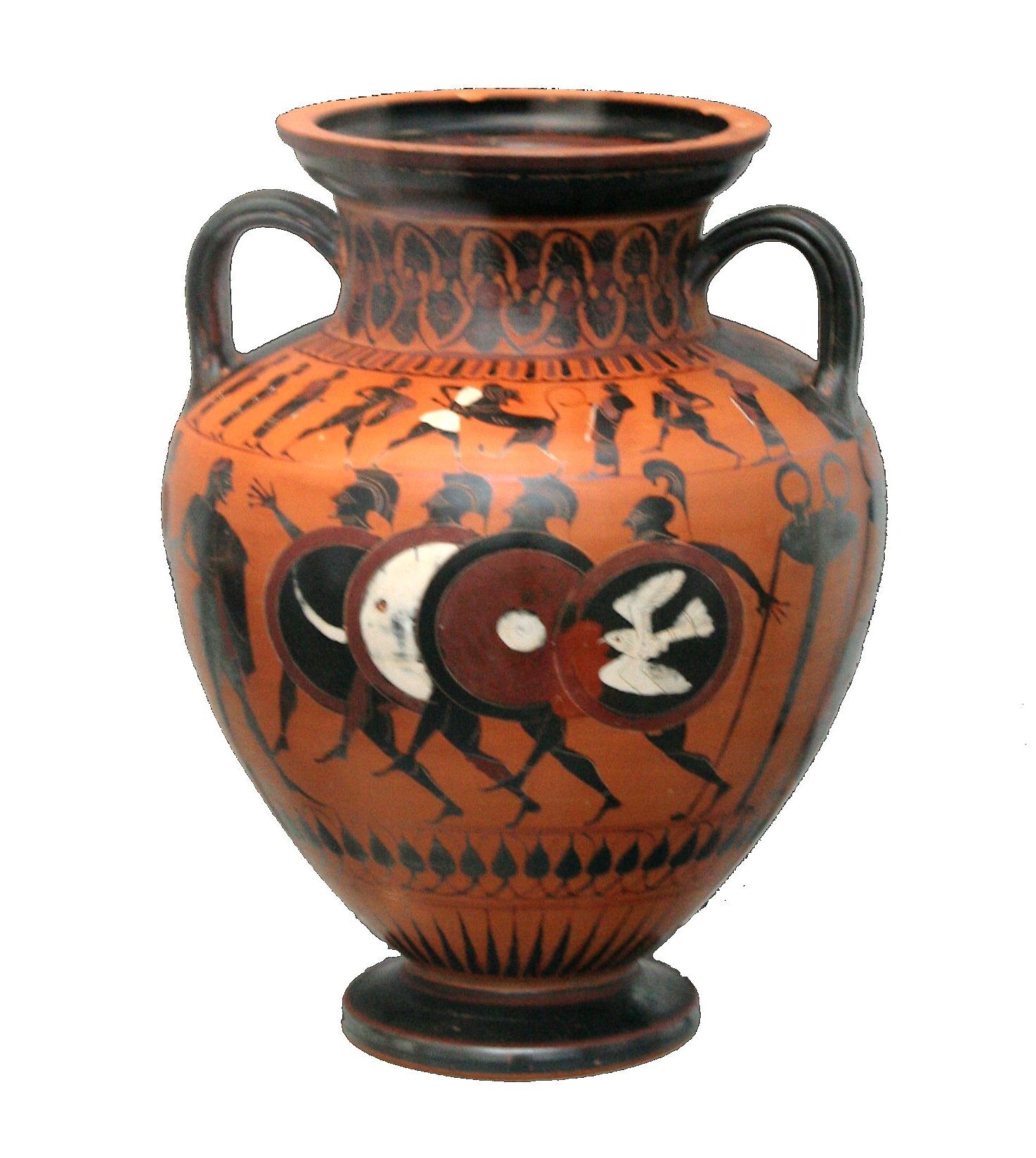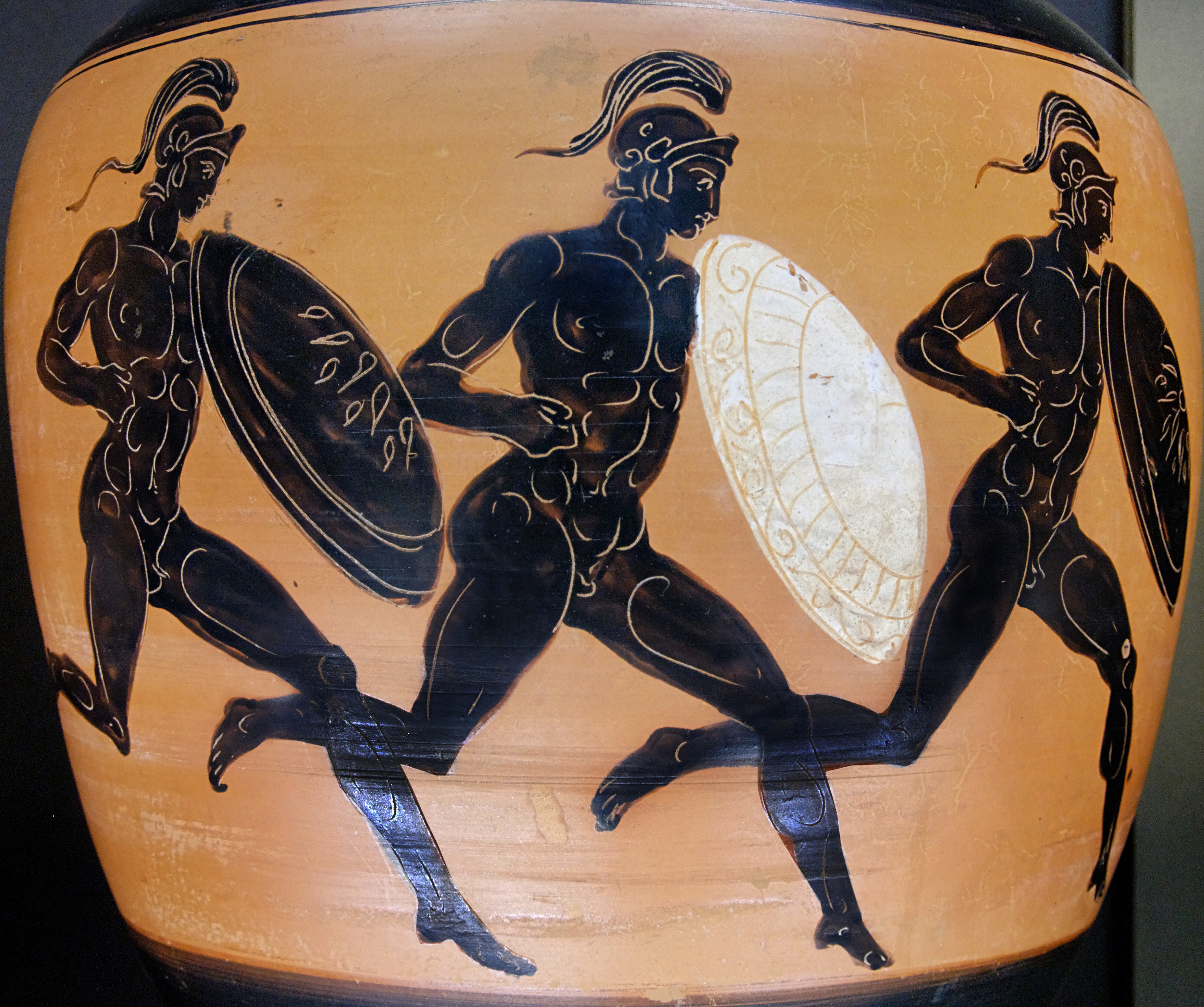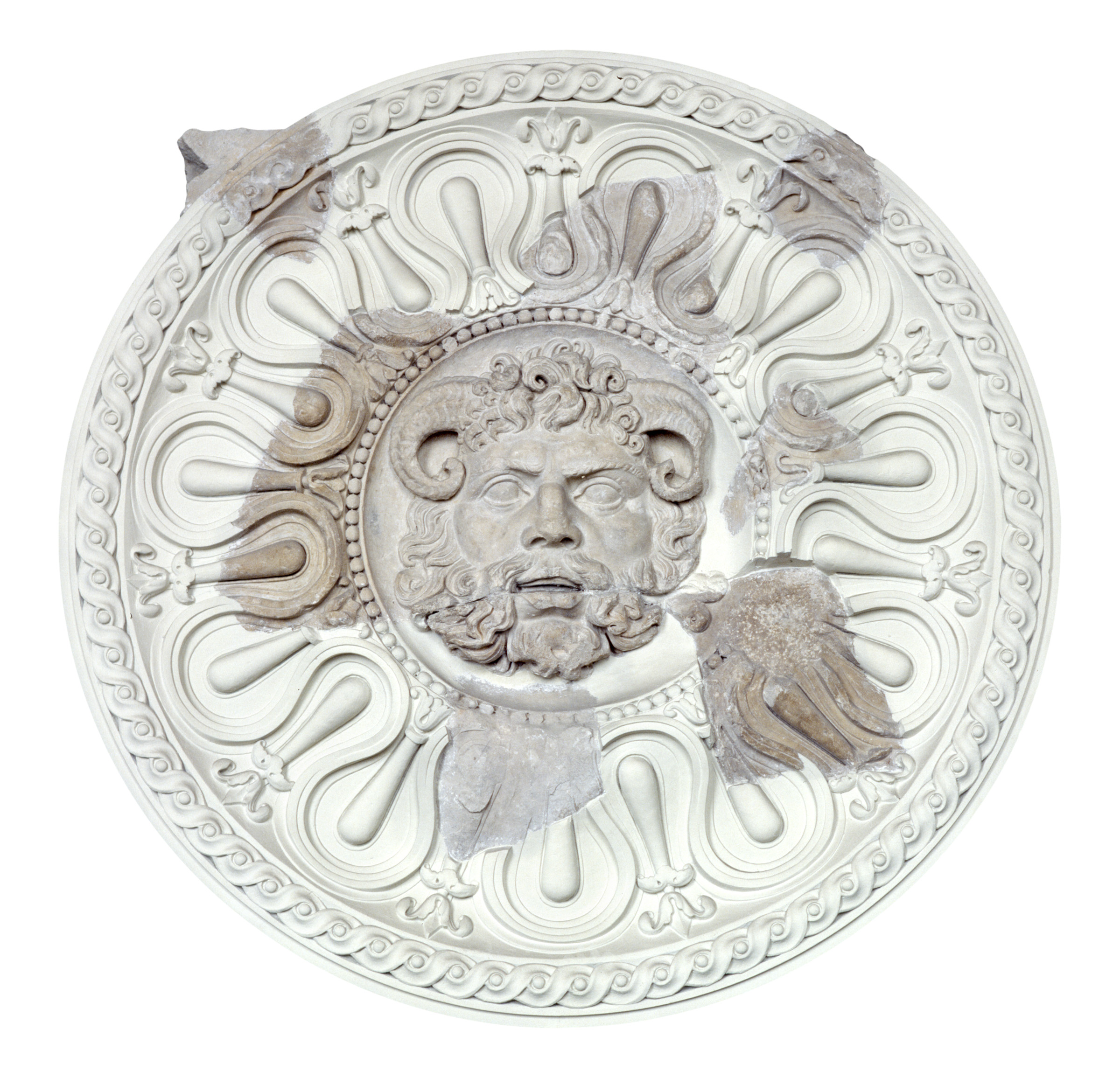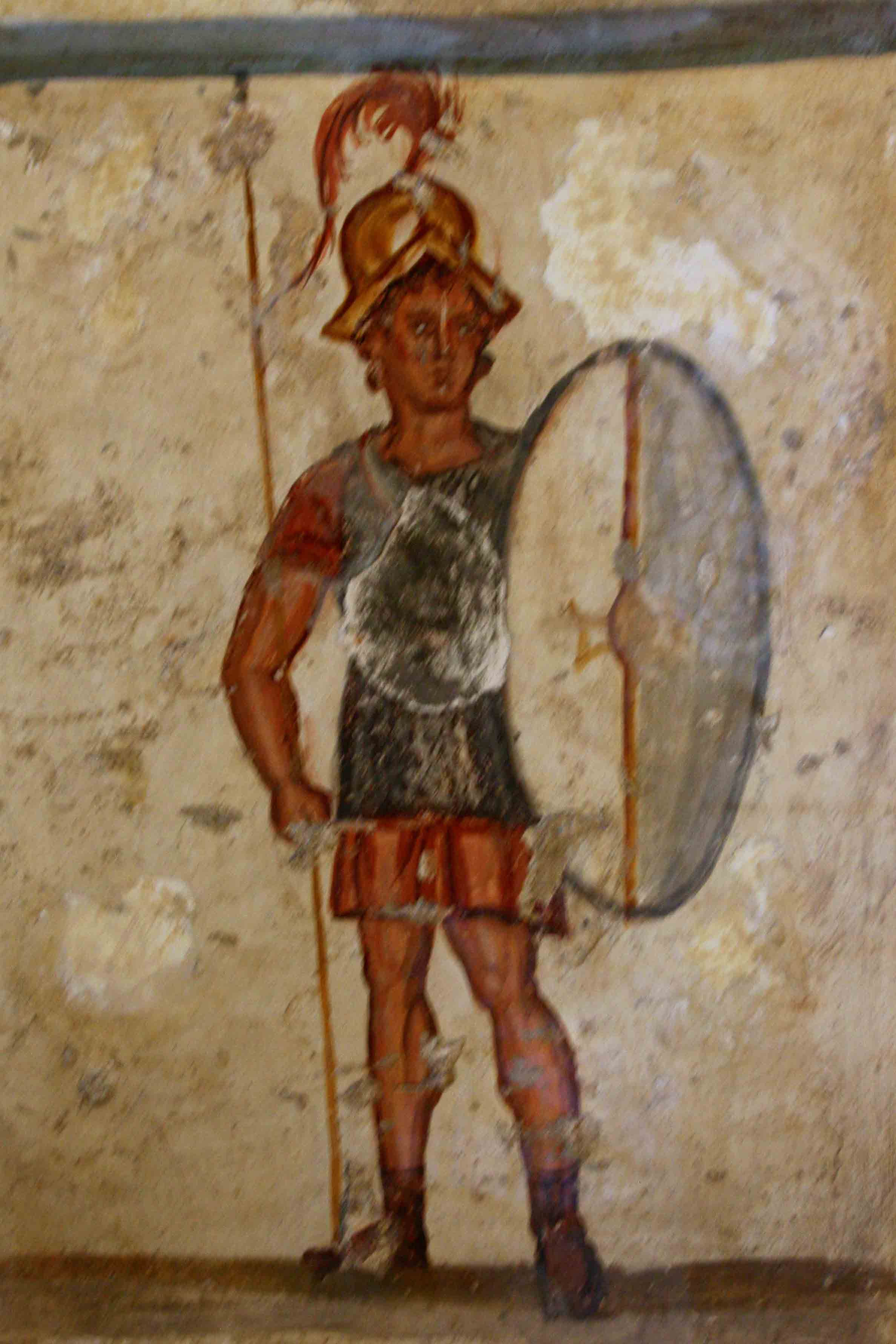|
Aspis
An aspis ( grc, ἀσπίς, plural ''aspides'', ), or porpax shield, sometimes mistakenly referred to as a hoplon ( el, ὅπλον) (a term actually referring to the whole equipment of a hoplite), was the heavy wooden shield used by the infantry in various periods of ancient Greece. Construction An aspis was deeply dished and made primarily of wood. Some had a thin sheet of bronze on the outer face, often just around the rim. In some periods, the convention was to decorate the shield; in others, it was usually left plain. The aspis measured at least in diameter and weighed about , and it was about thick. This large shield was made possible partly by its shape, which allowed it to be supported comfortably on the shoulder. The revolutionary part of the shield was, in fact, the grip. Known as an grip, it placed the handle at the edge of the shield and was supported by a leather or bronze fastening for the forearm at the center, known as the porpax. This allowed hoplit ... [...More Info...] [...Related Items...] OR: [Wikipedia] [Google] [Baidu] |
Phalanx
The phalanx ( grc, φάλαγξ; plural phalanxes or phalanges, , ) was a rectangular mass military formation, usually composed entirely of heavy infantry armed with spears, pikes, sarissas, or similar pole weapons. The term is particularly used to describe the use of this formation in ancient Greek warfare, although the ancient Greek writers used it to also describe any massed infantry formation, regardless of its equipment. Arrian uses the term in his ''Array against the Alans'' when he refers to his legions. In Greek texts, the phalanx may be deployed for battle, on the march, or even camped, thus describing the mass of infantry or cavalry that would deploy in line during battle. They marched forward as one entity. The term itself, as used today, does not refer to a distinctive military unit or division (e.g., the Roman legion or the contemporary Western-type battalion), but to the type of formation of an army's troops. Therefore, this term does not indicate a standard c ... [...More Info...] [...Related Items...] OR: [Wikipedia] [Google] [Baidu] |
Hoplite
Hoplites ( ) ( grc, ὁπλίτης : hoplítēs) were citizen-soldiers of Ancient Greek city-states who were primarily armed with spears and shields. Hoplite soldiers used the phalanx formation to be effective in war with fewer soldiers. The formation discouraged the soldiers from acting alone, for this would compromise the formation and minimize its strengths. The hoplites were primarily represented by free citizens – propertied farmers and artisans – who were able to afford a linen armour or a bronze armour suit and weapons (estimated at a third to a half of its able-bodied adult male population). Most hoplites were not professional soldiers and often lacked sufficient military training. Some states maintained a small elite professional unit, known as the '' epilektoi'' ("chosen") since they were picked from the regular citizen infantry. These existed at times in Athens, Argos, Thebes, and Syracuse, among other places. Hoplite soldiers made up the bulk of ... [...More Info...] [...Related Items...] OR: [Wikipedia] [Google] [Baidu] |
Othismos
Hoplites ( ) ( grc, ὁπλίτης : hoplítēs) were citizen-soldiers of Ancient Greek city-states who were primarily armed with spears and shields. Hoplite soldiers used the phalanx formation to be effective in war with fewer soldiers. The formation discouraged the soldiers from acting alone, for this would compromise the formation and minimize its strengths. The hoplites were primarily represented by free citizens – propertied farmers and artisans – who were able to afford a linen armour or a bronze armour suit and weapons (estimated at a third to a half of its able-bodied adult male population). Most hoplites were not professional soldiers and often lacked sufficient military training. Some states maintained a small elite professional unit, known as the '' epilektoi'' ("chosen") since they were picked from the regular citizen infantry. These existed at times in Athens, Argos, Thebes, and Syracuse, among other places. Hoplite soldiers made up the bulk of ancien ... [...More Info...] [...Related Items...] OR: [Wikipedia] [Google] [Baidu] |
ἀσπίς
An aspis ( grc, ἀσπίς, plural ''aspides'', ), or porpax shield, sometimes mistakenly referred to as a hoplon ( el, ὅπλον) (a term actually referring to the whole equipment of a hoplite), was the heavy wooden shield used by the infantry in various periods of ancient Greece. Construction An aspis was deeply dished and made primarily of wood. Some had a thin sheet of bronze on the outer face, often just around the rim. In some periods, the convention was to decorate the shield; in others, it was usually left plain. The aspis measured at least in diameter and weighed about , and it was about thick. This large shield was made possible partly by its shape, which allowed it to be supported comfortably on the shoulder. The revolutionary part of the shield was, in fact, the grip. Known as an grip, it placed the handle at the edge of the shield and was supported by a leather or bronze fastening for the forearm at the center, known as the porpax. This allowed hoplites ... [...More Info...] [...Related Items...] OR: [Wikipedia] [Google] [Baidu] |
Shield
A shield is a piece of personal armour held in the hand, which may or may not be strapped to the wrist or forearm. Shields are used to intercept specific attacks, whether from close-ranged weaponry or projectiles such as arrows, by means of active blocks, as well as to provide passive protection by closing one or more lines of engagement during combat. Shields vary greatly in size and shape, ranging from large panels that protect the user's whole body to small models (such as the buckler) that were intended for hand-to-hand-combat use. Shields also vary a great deal in thickness; whereas some shields were made of relatively deep, absorbent, wooden planking to protect soldiers from the impact of spears and crossbow bolts, others were thinner and lighter and designed mainly for deflecting blade strikes (like the roromaraugi or qauata). Finally, shields vary greatly in shape, ranging in roundness to angularity, proportional length and width, symmetry and edge pattern; differen ... [...More Info...] [...Related Items...] OR: [Wikipedia] [Google] [Baidu] |
Ancient Greek Warfare
Warfare occurred throughout the history of Ancient Greece, from the Greek Dark Ages onward. The Greek 'Dark Ages' drew to an end as a significant increase in population allowed urbanized culture to be restored, which led to the rise of the city-states (''Poleis''). These developments ushered in the period of Archaic Greece (800–480 BC). They also restored the capability of organized warfare between these '' Poleis'' (as opposed to small-scale raids to acquire livestock and grain, for example). The fractious nature of Ancient Greek society seems to have made continuous conflict on this larger scale inevitable. Along with the rise of the city- states evolved a new style of warfare: the hoplite phalanx. Hoplites were armored infantrymen, armed with spears and shields. Seen in media, the phalanx was a formation of these soldiers with their shields locked together and spears pointed forward. The Chigi vase, dated to around 650 BC, is the earliest depiction of a hoplite in full bat ... [...More Info...] [...Related Items...] OR: [Wikipedia] [Google] [Baidu] |
Hoplitodromos Staatliche Antikensammlungen 1471
The hoplitodromos or hoplitodromia (Greek: , English translation: "race of the Hoplites") was an ancient foot race, part of the Olympic Games and the other Panhellenic Games. It was the last foot race to be added to the Olympics, first appearing at the 65th Olympics in 520 BC, and was traditionally the last foot race to be held. Unlike the other races, which were generally run in the nude, the ''hoplitodromos'' required competitors to run wearing the ''hopla'', the helmet, greaves and heavy shield (''aspis'') from which the hoplite infantryman took its name, bringing the total encumbrance to at least 6 kg (12 pounds).Peter Krentz, “A Cup by Douris and the Battle of Marathon,” in Garrett G. Fagan and Matthew Trundle (eds.), New Perspectives on Ancient Warfare (Brill: Leiden, 2010) pp. 190ff. As the ''hoplitodromos'' was one of the shorter foot races, the heavy armor and shield was less a test of endurance than one of sheer muscular strength. After 450 BC, the use of greaves w ... [...More Info...] [...Related Items...] OR: [Wikipedia] [Google] [Baidu] |
Clipeus
In the military of classical antiquity, a ''clipeus'' (, Ancient Greek: ἀσπίς) was a large shield worn by the Greek hoplites and Romans as a piece of defensive armor, which they carried upon the arm, to protect them from the blows of their enemies. It was round in shape and in the middle was a bolt of iron, or of some other metal, with a sharp point. The ''clipeus'' was more-or-less identical to the earlier ''aspis''. Decorative use Pliny the Elder also describes the custom of having a bust-portrait of an ancestor painted on a ''clipeus'', and having it hung in a temple or other public place. From this round bas-reliefs in a medallion on sarcophagi and in other forms are known as "''clipeus'' portraits". Roman use The ''clipeus'' was used by Romans during the Roman Kingdom and early republic but was replaced by the legionary ''scutum'', a convex rectangular shield, in the later Roman Republic. However, the ''scutum'' disappeared during the Crisis of the Third Century. ... [...More Info...] [...Related Items...] OR: [Wikipedia] [Google] [Baidu] |
Peltast
A ''peltast'' ( grc-gre, πελταστής ) was a type of light infantryman, originating in Thrace and Paeonia, and named after the kind of shield he carried. Thucydides mentions the Thracian peltasts, while Xenophon in the Anabasis distinguishes the Thracian and Greek peltast troops. The peltast often served as a skirmisher in Hellenic and Hellenistic armies. In the Medieval period, the same term was used for a type of Byzantine infantryman. Description ''Pelte'' shield ''Peltasts'' carried a crescent-shaped wicker shield called a "''pelte''" ( Ancient Greek grc, πέλτη, peltē, label=none; Latin: ) as their main protection, hence their name. According to Aristotle, the ''pelte'' was rimless and covered in goat- or sheepskin. Some literary sources imply that the shield could be round, but in art it is usually shown as crescent-shaped. It also appears in Scythian art and may have been a common type in Central Europe. The shield could be carried with a central strap ... [...More Info...] [...Related Items...] OR: [Wikipedia] [Google] [Baidu] |
Thyreos
A thyreos ( grc, θυρεός) was a large oval shield which was commonly used in Hellenistic armies from the 3rd century BC onwards. It was adopted from the Galatians, probably first by the Illyrians, then by the Thracians before becoming common in ancient Greece Ancient Greece ( el, Ἑλλάς, Hellás) was a northeastern Mediterranean civilization, existing from the Greek Dark Ages of the 12th–9th centuries BC to the end of classical antiquity ( AD 600), that comprised a loose collection of cu .... Troops who carried it were known as thyreophoroi. It was made of wood covered with leather and had a spined boss. It was carried using a central handgrip. Some variants of the shield were nearly rectangular: the name thyreos derives from the word ''thyra'' (θύρα), "door", reflecting its oblong shape. See also * Hellenistic armies * Antigonid Macedonian army References {{reflist Ancient Greek military terminology Greek shields ... [...More Info...] [...Related Items...] OR: [Wikipedia] [Google] [Baidu] |
Thorakitai
The ''thorakitai'' ( el, θωρακίται, singular: θωρακίτης, ''thorakites'') were a type of soldier in Hellenistic armies similar to the ''thureophoroi''. The literal translation of the term is "cuirassiers", which suggests that they may have worn a short Celtic mail shirt or possibly a ''linothorax''. Role ''Thorakitai'' were used in armies of the Hellenistic period in a variety of tactical situations. They were a type of armoured but mobile infantry who did not require a rigid formation to be effective in combat. From their name we can deduce that most wore armor and helmet. They bore a ''thureos'', an oval shield, and were armed with sword, javelins and spear, which were used according to their tactical use. It seems that the ''thorakitai'' were heavily armored ''thureophoroi'', able to bear spears and do battle in a phalanx as well as engage in irregular warfare in situations when such an action was required for tactical reasons, like to exploit or challenge rough ... [...More Info...] [...Related Items...] OR: [Wikipedia] [Google] [Baidu] |
Thyreophoroi
The ''thyreophoroi'' or ''thureophoroi'' ( el, θυρεοφόροι; singular: ''thureophoros''/''thyreophoros'', θυρεοφόρος) were a type of infantry soldier, common in the 3rd to 1st centuries BC, who carried a large oval shield called a ''thyreos'' which had a type of metal strip boss and a central spine. They were armed with a long thrusting spear, javelins and a sword. They also usually wore an iron or bronze Macedonian helmet. The ''thureos'' was probably originally an adapted form of a Celtic shield. Thracian and Illyrian infantry probably adopted the shield before the Greeks. However, it has been suggested that the ''thureos'' was brought to Greece after Pyrrhus of Epirus' campaigns in Italy, as his Oscan allies and Roman enemies used the ''scutum''. Role ''Thyreophoroi'' are usually distinguished from both skirmishers and the phalanx and seem to have operated in a role intermediate between the two types. They often supported light troops and seemed to be capable o ... [...More Info...] [...Related Items...] OR: [Wikipedia] [Google] [Baidu] |

.jpg)






